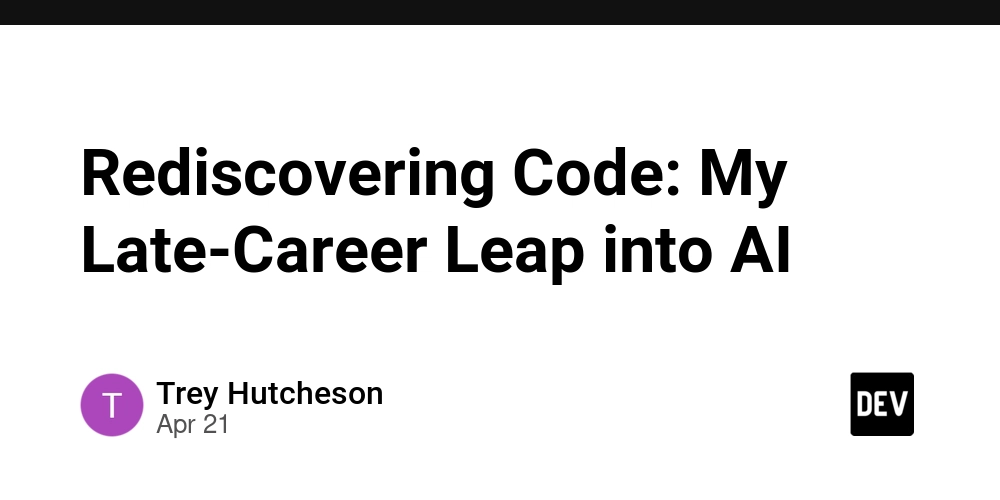Rediscovering Code: My Late-Career Leap into AI
Starting Over (Sort Of): A Late-Career Dev Dives into AI Hi, I'm Trey — and I've been in software development for almost 30 years. Most of that time has been spent as an individual contributor, though I've also held tech lead, team lead, and architectural roles. For the past three years, I've been in management. Now, I’m at an interesting crossroads: do I continue growing in management, or do I return to being a hands-on developer? The Joy of Management Management has been rewarding. Coaching and mentoring engineers (and other managers), helping teams through reorgs, and even supporting teammates on personal milestones like gaining permanent residency — it's all been incredibly fulfilling. Making a difference in someone's life is powerful. But lately, I’ve felt the pull to get my hands dirty again. Back to the Code Working 60–80 hours a week left little time for personal growth. Now, if I return to development, I'll be playing catch-up with many trends that passed me by. I started in the late 90s doing desktop development in Visual Basic. I participated in the rise of Java and .NET, helped several companies through the waterfall-to-scrum transition, and built software at companies ranging from startups to multinational corporations. In the 2010s, I moved into architectural roles. It was a perfect balance: working on interesting tech while also growing my leadership skills. My Technical Background Over the past decade, my focus has been distributed systems — from on-prem monoliths to cloud-native microservices. I’m fascinated by distributed computing problems: consensus, replication, and the complexities of reliability at scale. Here’s a quick snapshot of my tech experience: Languages/Platforms: Java/Kotlin (heavy focus), .NET (early on), with a little bit of Rust Frameworks & Tools: Spring Boot, Quarkus, Kafka, Kubernetes CI/CD: Jenkins, Azure DevOps Infrastructure: Linux, containerization, and Ansible (for IaC) Architectural roles pulled me away from day-to-day coding, but I stayed close to system design, scale, and operations. Left Behind by AI (Until Now) Despite staying aware of AI and LLMs conceptually, I’ve had no real hands-on experience. I’m changing that now. This blog will document my journey from zero to (hopefully) proficient in applying AI to real-world software problems. Some of it will be slow, some clunky, and much of it will be me learning in public. If you're a late-career engineer like me — curious about AI, but unsure where to start — this blog is for you. What's Coming Next I’m starting with something personal: my own checkbook/ledger. In the next post, I’ll explain why that’s the perfect launch point. From there, I’ll see how far AI-generated code can take me. The series will cover: Tool selection & configuration Coding experiments & outcomes Lessons learned along the way All the source code will be open and available to follow along. Thanks for reading — and if you're on a similar path, I’d love to hear from you.

Starting Over (Sort Of): A Late-Career Dev Dives into AI
Hi, I'm Trey — and I've been in software development for almost 30 years. Most of that time has been spent as an individual contributor, though I've also held tech lead, team lead, and architectural roles. For the past three years, I've been in management.
Now, I’m at an interesting crossroads: do I continue growing in management, or do I return to being a hands-on developer?
The Joy of Management
Management has been rewarding. Coaching and mentoring engineers (and other managers), helping teams through reorgs, and even supporting teammates on personal milestones like gaining permanent residency — it's all been incredibly fulfilling. Making a difference in someone's life is powerful.
But lately, I’ve felt the pull to get my hands dirty again.
Back to the Code
Working 60–80 hours a week left little time for personal growth. Now, if I return to development, I'll be playing catch-up with many trends that passed me by.
I started in the late 90s doing desktop development in Visual Basic. I participated in the rise of Java and .NET, helped several companies through the waterfall-to-scrum transition, and built software at companies ranging from startups to multinational corporations.
In the 2010s, I moved into architectural roles. It was a perfect balance: working on interesting tech while also growing my leadership skills.
My Technical Background
Over the past decade, my focus has been distributed systems — from on-prem monoliths to cloud-native microservices. I’m fascinated by distributed computing problems: consensus, replication, and the complexities of reliability at scale.
Here’s a quick snapshot of my tech experience:
- Languages/Platforms: Java/Kotlin (heavy focus), .NET (early on), with a little bit of Rust
- Frameworks & Tools: Spring Boot, Quarkus, Kafka, Kubernetes
- CI/CD: Jenkins, Azure DevOps
- Infrastructure: Linux, containerization, and Ansible (for IaC)
Architectural roles pulled me away from day-to-day coding, but I stayed close to system design, scale, and operations.
Left Behind by AI (Until Now)
Despite staying aware of AI and LLMs conceptually, I’ve had no real hands-on experience. I’m changing that now.
This blog will document my journey from zero to (hopefully) proficient in applying AI to real-world software problems. Some of it will be slow, some clunky, and much of it will be me learning in public.
If you're a late-career engineer like me — curious about AI, but unsure where to start — this blog is for you.
What's Coming Next
I’m starting with something personal: my own checkbook/ledger. In the next post, I’ll explain why that’s the perfect launch point.
From there, I’ll see how far AI-generated code can take me. The series will cover:
- Tool selection & configuration
- Coding experiments & outcomes
- Lessons learned along the way
All the source code will be open and available to follow along.
Thanks for reading — and if you're on a similar path, I’d love to hear from you.
















_Weyo_alamy.png?width=1280&auto=webp&quality=80&disable=upscale#)















































